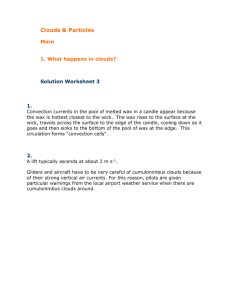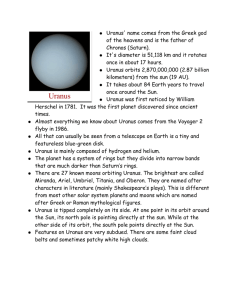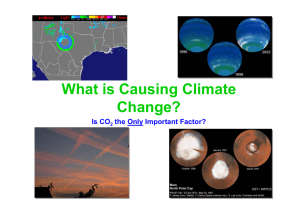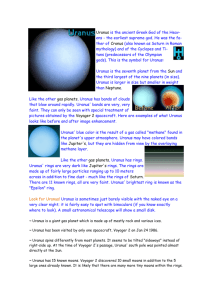Planetary Storms/Observing Convection Currents
advertisement
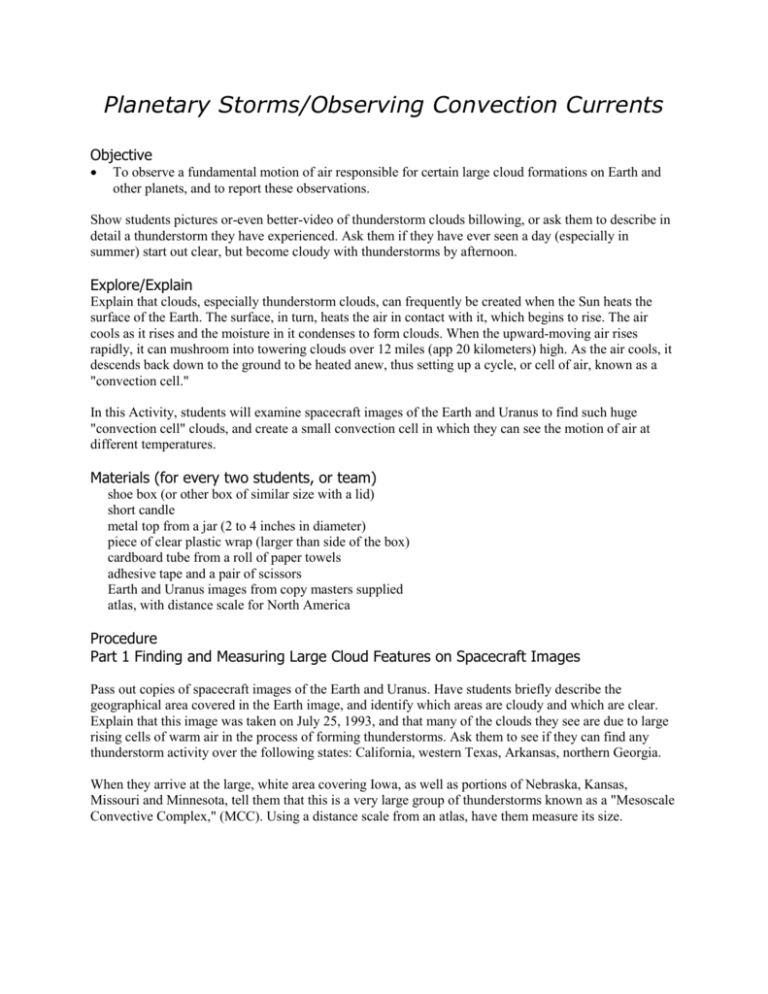
Planetary Storms/Observing Convection Currents Objective To observe a fundamental motion of air responsible for certain large cloud formations on Earth and other planets, and to report these observations. Show students pictures or-even better-video of thunderstorm clouds billowing, or ask them to describe in detail a thunderstorm they have experienced. Ask them if they have ever seen a day (especially in summer) start out clear, but become cloudy with thunderstorms by afternoon. Explore/Explain Explain that clouds, especially thunderstorm clouds, can frequently be created when the Sun heats the surface of the Earth. The surface, in turn, heats the air in contact with it, which begins to rise. The air cools as it rises and the moisture in it condenses to form clouds. When the upward-moving air rises rapidly, it can mushroom into towering clouds over 12 miles (app 20 kilometers) high. As the air cools, it descends back down to the ground to be heated anew, thus setting up a cycle, or cell of air, known as a "convection cell." In this Activity, students will examine spacecraft images of the Earth and Uranus to find such huge "convection cell" clouds, and create a small convection cell in which they can see the motion of air at different temperatures. Materials (for every two students, or team) shoe box (or other box of similar size with a lid) short candle metal top from a jar (2 to 4 inches in diameter) piece of clear plastic wrap (larger than side of the box) cardboard tube from a roll of paper towels adhesive tape and a pair of scissors Earth and Uranus images from copy masters supplied atlas, with distance scale for North America Procedure Part 1 Finding and Measuring Large Cloud Features on Spacecraft Images Pass out copies of spacecraft images of the Earth and Uranus. Have students briefly describe the geographical area covered in the Earth image, and identify which areas are cloudy and which are clear. Explain that this image was taken on July 25, 1993, and that many of the clouds they see are due to large rising cells of warm air in the process of forming thunderstorms. Ask them to see if they can find any thunderstorm activity over the following states: California, western Texas, Arkansas, northern Georgia. When they arrive at the large, white area covering Iowa, as well as portions of Nebraska, Kansas, Missouri and Minnesota, tell them that this is a very large group of thunderstorms known as a "Mesoscale Convective Complex," (MCC). Using a distance scale from an atlas, have them measure its size. Next, have them examine the HST image of Uranus. Contrast it to the image of Earth, and have them identify the two large cloud complexes they find. Given that the diameter of Uranus is 31,771 miles (51,120 kilometers), have them estimate the size of these cloud features. How does the size of these convection cloud features on Uranus compare with the one over Earth. How much of the U.S. would they cover if brought to Earth? Part 2 Creating a Convection Cell Have students cut out most of one of the long sides of their shoe boxes and cover it with clear plastic, making a window. Have them cut two holes in the lid just large enough for the sections of cut paper tube to fit through, as shown in the illustration. When ready, carefully light the candles and close the lid, making sure that the candle lies directly under one hole. Carefully place the smoking tip of a punk, or the smoking end of a tight curve of paper, near the top of cardboard tube #2. Smoke introduced over the right "roof chimney" will descend since it's cool, and travel across the length of the box to rise out of the "left chimney" because of the rising current of warm air from the candle. (Note: a similar activity can also be done as a demonstration using a fish aquarium. Place room temperature water in the aquarium, filling it to about 3/4 of the way up. Place an aquarium heater at one end, and drape a plastic bag with ice cubes into the water at the other end. Allow the water to settle, then gently place a few drops of blue food coloring into the water near the ice cubes, and red food coloring near the base of the heater, using a long- nosed dropper. Within a few minutes, the food coloring will begin to trace out the cycle of currents in the water.) Pose the following questions to the students: In the experiment you just completed, the candle supplied the heat causing the air to rise. What is the source of heat that causes air to rise and form clouds on Earth? What is the source of heat that does the same thing on the giant planets in our solar system like Uranus? Expand Go on-line and research the extensive weather-related materials which can be found there. The HST Home Page will provide some of the best links. Send e-mail questions via LHST's Researcher Q&A to astronomers and scientists who are awaiting your inquiries! © PASSPORT TO KNOWLEDGE

